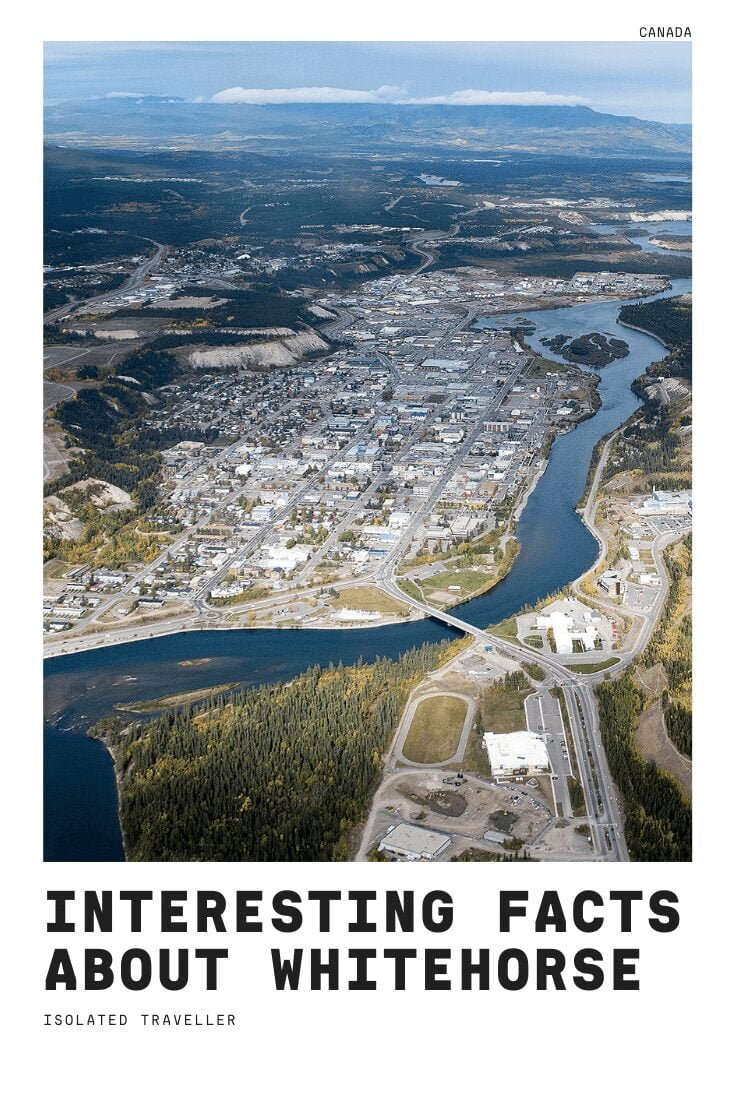Facts About Whitehorse
-
Whitehorse is the capital and only city of Yukon, and the largest city in northern Canada.
-
Whitehorse is referred to as The Wilderness City.
-
Whitehorse was incorporated into a city in 1950.
-
Whitehorse’s downtown and Riverdale areas occupy both shores of the Yukon River, which originates in British Columbia and meets the Bering Sea in Alaska.
-
The discovery of gold in the Klondike in August 1896, by Skookum Jim, Tagish Charlie, and George Washington Carmack, set off a major change in the historical patterns of the region.
-
The Estimated Population of Whitehorse is 25,085.
-
The city was named after the White Horse Rapids for their resemblance to the mane of a white horse, near Miles Canyon before the river was dammed.
-
Archaeological research south of the downtown area, at a location known as Canyon City, has revealed evidence of use by First Nations for several thousand years.
-
Whitehorse measuring in at a massive 416.54 km2.
-
In 1970 the Metropolitan Whitehorse development plan included park and greenbelt areas that were to be preserved to ensure high quality of life even within city limits.
-
Whitehorse has its own fire service, known as the City of Whitehorse Fire Department with two fire stations.
-
In summer daylight can last as long as 20 hours. In the winter daylight can be as brief as 6.5 hours.
-
Notable politicians include the first female mayor of Whitehorse, in 1975, Ione Christensen, whose family had moved to Whitehorse in 1949, and Yukon’s first senator, in 1975, Paul Lucier, who stayed in office until his death in 1999.
-
As a federal territory, the Yukon is officially bilingual in English and French.
-
Whitehorse’s Yukon Arts Centre offers all varieties of shows and artists and includes an art gallery.
-
In Whitehorse, only 8.4 % of the population is over 65, less than the national average. The median age is 38.1 years.
-
On April 1, 1953, the city was designated as the capital of the Yukon Territory when the seat was moved from Dawson City after the construction of the Klondike Highway.
-
On March 21, 1957, the name was officially changed from White Horse to Whitehorse.
-
Notable athletes are Whitehorse born hockey players Bryon Baltimore, who made it to the Los Angeles Kings in 1974, and Peter Sturgeon who played for the Colorado Rockies in 1974, Whitehorse-born Olympic cyclist Zachary Bell, Whitehorse-raised Olympic weightlifter Jeane Lassen who won medals in several world competitions, Whitehorse-born basketball players Aaron Olson, and 1984 Olympics centre for Team Canada Greg Wiltjer.
-
Whitehorse is between 670–1,702 m above sea level.
-
In 2019, Whitehorse recorded its warmest March on record, having 9 days above 10.0 °C and hit a maximum high of 13.8 °C on March 20
-
The highest temperature ever recorded in Whitehorse was 35.6 °C on 14 June 1969. The coldest temperature ever recorded was −56.1 °C on 21 January 1906.
-
Whitehorse is home to approximately 70 per cent of the entire population of Yukon Territory.
-
Whitehorse is twinned with Juneau, Alaska, USA; Lancieux, France & Ushiku, Japan.
-
Due to Whitehorse’s unique urban development objectives and varied topography, neighbourhoods are usually separated from each other by large geographical features. In addition to the city’s downtown core on the Yukon River’s west bank, two subdivisions sit at the same elevation as the Yukon River, 640 m.
-
In 1953 the capital of the Yukon Territory was transferred from Dawson City to Whitehorse
-
Whitehorse is the driest city in Canada.
-
Whitehorse’s newest subdivision began in 2010 on the “Lower Bench” east of the Porter Creek subdivision.
-
Whitehorse municipal elections are held every three years.
-
Whitehorse has historically city partnerships with Echuca, Australia & Patos de Minas, Brazil.


